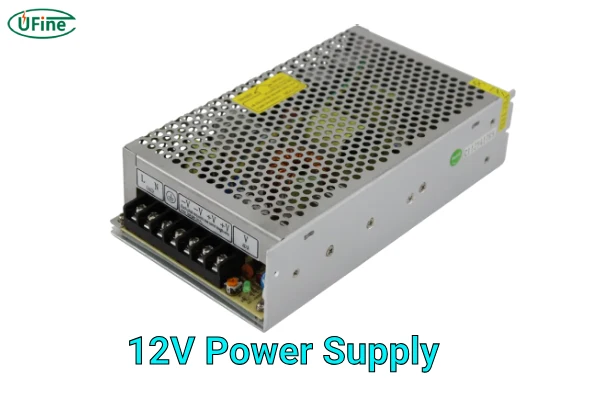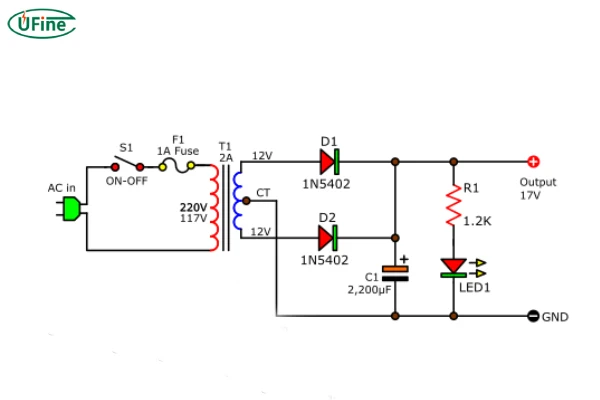Whether it’s powering up LED lights in your home, giving life to your car’s electronics, or supporting industrial equipment, the 12V power supply is everywhere. It’s one of those unsung heroes, silently delivering just the right amount of power to keep everything running smoothly. But what really goes on behind the scenes? Why is the 12V power supply so essential, and how does it work? This article will take you on a journey through the world of 12V power supplies, helping you understand their purpose, design, and real-life applications. Let’s dive in!
Part 1. Overview of the 12V power supply
The 12V power supply is designed to convert an input voltage (usually AC) into a stable 12-volt DC output, suitable for a variety of electronic devices and systems. Its job may seem straightforward, but its impact is huge. When you need stable and reliable power for sensitive equipment, a 12V power supply can be your best friend. Unlike batteries, which can deplete and are often affected by temperature, a 12V power supply offers consistent power as long as it’s connected.
These supplies are known for their stability, energy efficiency, and adaptability. A 12V power supply doesn’t just power up your devices—it protects them too. By regulating voltage and managing power fluctuations, it prevents the risk of short circuits, overheating, or damage that could otherwise result from sudden surges. The 12V power supply’s reliability and versatility make it indispensable in both home and industrial environments.
Part 2. Working principle of a 12V power supply
So, how does a 12V power supply do its job? A typical 12V power supply works by converting high-voltage AC power from an outlet into a safer, lower-voltage DC output. This process involves several critical components:
- Transformer: This reduces the high input AC voltage to a lower AC voltage.
- Rectifier: Converts AC voltage to pulsating DC voltage.
- Filter: Smooths out the DC voltage to reduce any fluctuations.
- Voltage Regulator: Ensures a stable 12V output, regardless of changes in input or load.
The transformer steps down the incoming AC voltage to a manageable level, then the rectifier, typically composed of diodes, converts it to DC. Next, the filter—often a capacitor—helps smooth the DC signal, ensuring it doesn’t fluctuate wildly. Finally, the voltage regulator steps in to ensure that the output remains steady at exactly 12 volts, making it ideal for delicate electronics.
Understanding the inner workings can help you appreciate why these components are so crucial. Each one has a unique role to play, and together, they ensure that your devices receive clean, steady power.
Part 3. Types of 12V power supplies
Not all 12V power supplies are the same. Depending on the design and purpose, they come in several types, each with its own strengths:
- Linear Power Supply: Known for stability and low noise, but tends to be less efficient and bulky.
- Switching Power Supply (SMPS): Highly efficient and compact, making it a popular choice for modern devices.
- Regulated Power Supply: Designed to maintain a precise 12V output even if input voltage fluctuates.
- Unregulated Power Supply: Simpler and cheaper but can have variable output under different loads.
- AC-DC Power Supply: Converts AC input into 12V DC output, commonly used in household electronics.
- Battery-Based Power Supply: Portable and rechargeable, suitable for mobile devices and off-grid applications.
- Industrial Power Supply: Heavy-duty with added protections for applications in manufacturing and factory automation.
Each type has unique benefits, and the choice often depends on the specific needs of the device or system. Linear power supplies, for instance, offer smooth and stable power, but switching power supplies have become more popular due to their compact size and efficiency. Industrial power supplies are designed for environments where durability and added safety features are a must.
Part 4. Key parameters of a 12V power supply
When selecting a 12V power supply, it’s essential to consider several key parameters to ensure compatibility with your devices. Here are the most important ones to know:
- Output Voltage: This should be 12V, but it’s crucial to verify that it remains stable under various conditions.
- Output Current (Amps): Determines the maximum load the power supply can handle without overheating.
- Power Rating (Watts): This is calculated by multiplying output voltage and current (12V × Amps).
- Efficiency: Higher efficiency means less energy wasted as heat, which is important for long-term cost savings.
- Ripple & Noise: Ideally, this should be low to ensure that your devices receive clean, stable power.
- Protection Features: Look for features like over-voltage, over-current, and short-circuit protection.
- Operating Temperature Range: Crucial for environments that are either very hot or very cold.
Choosing the right power supply involves matching these parameters to the specific needs of your application. Each of these factors affects performance and longevity, so paying attention to them can make a big difference.
Part 5. 12V power supply circuit
In a basic 12V power supply circuit, several stages work together to convert and stabilize the power:
- Transformer Stage: Steps down the input AC voltage.
- Rectifier Stage: Converts AC to pulsating DC.
- Filter Stage: Reduces DC fluctuations, providing a smoother output.
- Voltage Regulator Stage: Keeps the output stable at exactly 12V.
More advanced circuits may include components like fuses and relays to add layers of safety and durability. Understanding this circuit design can be incredibly helpful if you ever need to troubleshoot or modify a 12V power supply.
Part 6. What is a 12V power supply used for?
A 12V power supply’s versatility makes it suitable for numerous applications, from household items to industrial equipment. Here are some common uses:
- LED Lighting: Powers LED strips and lights, providing steady illumination.
- Security Systems: Powers cameras and alarms for consistent performance.
- Automotive Electronics: Used in dashboards, sensors, and auxiliary car devices.
- Audio Equipment: Powers amplifiers and speakers.
- Computer Peripherals: Essential for hard drives, fans, and other components.
- Industrial Controls: Reliable power for control panels and automation systems.
- Portable Electronics: Used in devices like power banks and rechargeable gadgets.
The flexibility and reliability of a 12V power supply make it ideal for applications where consistent power is essential.
Part 7. 12V power supply vs. 12V battery: what’s the difference?
A 12V power supply and a 12V battery may both deliver the same voltage, but they serve very different purposes. A 12V power supply is usually AC-powered, providing a steady, continuous current ideal for stationary devices that need a constant power source.
In contrast, a 12V battery is a portable, rechargeable source of power. It’s useful for applications requiring mobility, like powering an off-grid device or a backup power source. Batteries have a finite charge, which means their voltage can fluctuate as they drain. For applications that need uninterrupted power, such as security systems, a 12V power supply is a better choice.
Part 8. Common faults and troubleshooting
While 12V power supplies are generally reliable, they can occasionally run into problems. Here are some common issues and troubleshooting tips:
- No Output Voltage: Check the input connections and ensure there’s power at the source.
- Overheating: Ensure proper ventilation around the power supply, and verify that it’s not overloaded.
- Fluctuating Voltage: Inspect for loose wires or connections.
- Noise or Ripple: Examine the capacitors and other filter components; they may need replacement.
- Short Circuit: Disconnect the load and inspect the device and wiring for damage.
- High Output Voltage: Test the regulator component, as it may need replacement.
- Random Shutdowns: Check for overheating or overloading, and ensure all connections are secure.
Routine maintenance, including inspecting wiring and connections, can help prevent many of these issues. A little preventative care goes a long way in extending the life of your power supply.
Part 9. Final words
A 12V power supply might seem like a small component, but it’s one that has a huge impact on the world around us. From powering our home gadgets to keeping factories running, its presence is felt everywhere. By understanding its design, types, and key parameters, you’ll be able to select the right power supply for your needs and troubleshoot issues effectively. So next time you switch on an LED light or use a security camera, you’ll know there’s a 12V power supply working quietly behind the scenes to keep things going strong.
Related Tags:
More Articles

How to Choose the Best Floor Scrubber Battery for Commercial Cleaning?
Selecting the ideal floor scrubber battery ensures a long runtime, rapid charging, and minimal maintenance for efficient commercial cleaning operations.
Battery for Blower vs Battery for Leaf Vacuum: Which One Should You Choose?
Battery for blower vs leaf vacuum—learn the key differences in power, fit, and runtime to choose the right battery for your outdoor tool needs.
How to Choose the Right Battery for Blower?
Choosing the right blower battery? Consider voltage, capacity, chemistry & usage. This guide helps match the best battery for peak performance.
How to Choose the Best Insulated Battery Box for Lithium Batteries?
Choosing the Best Insulated Battery Box for Lithium Batteries? Discover key factors such as size, material, and safety for optimal protection and performance.
7 Critical Elements on a Lithium Battery Shipping Label
What must be on a lithium battery shipping label? Learn 7 key elements to ensure safety, legal compliance, and correct handling across all transport modes.





